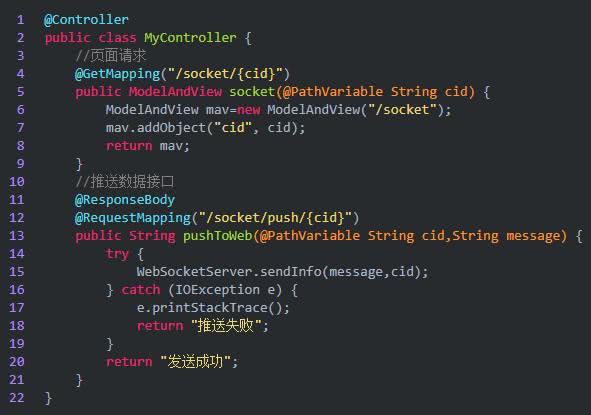Spring Boot 集成 WebSocket 实现服务端推送消息到客户端
WebSocket 简介
WebSocket 协议是基于 TCP 的一种新的网络协议,它实现了浏览器与服务器全双工(full-duplex)通信—允许服务器主动发送信息给客户端,这样就可以实现从客户端发送消息到服务器,而服务器又可以转发消息到客户端,这样就能够实现客户端之间的交互。对于 WebSocket 的开发,Spring 也提供了良好的支持,目前很多浏览器已经实现了 WebSocket 协议,但是依旧存在着很多浏览器没有实现该协议,为了兼容那些没有实现该协议的浏览器,往往还需要通过 STOMP 协议来完成这些兼容。
下面我们在 Spring Boot 中集成 WebSocket 来实现服务端推送消息到客户端。
Spring Boot 集成 WebSocket
首先创建一个 Spring Boot 项目,然后在 pom.xml 加入如下依赖集成 WebSocket:
org.springframework.boot
spring-boot-starter-websocket
开启配置
接下来在 config 包下创建一个 WebSocket 配置类 WebSocketConfiguration,在配置类上加入注解 @EnableWebSocket,表明开启 WebSocket,内部实例化 ServerEndpointExporter 的 Bean,该 Bean 会自动注册 @ServerEndpoint 注解声明的端点,代码如下:
@Configuration
@EnableWebSocket
public class WebSocketConfiguration {
@Bean
public ServerEndpointExporter serverEndpointExporter() {
return new ServerEndpointExporter();
}
}编写端点服务类
接下来使用 @ServerEndpoint 定义一个端点服务类,在端点服务类中,可以定义 WebSocket 的打开、关闭、错误和发送消息的方法,具体代码如下所示:
package worn.xiao.riskmsg.service;
import com.alibaba.fastjson.JSONObject;
import org.slf4j.Logger;
import org.slf4j.LoggerFactory;
import org.springframework.stereotype.Component;
import org.springframework.util.StringUtils;
import javax.websocket.*;
import javax.websocket.server.PathParam;
import javax.websocket.server.ServerEndpoint;
import java.io.IOException;
import java.text.SimpleDateFormat;
import java.util.Date;
import java.util.concurrent.ConcurrentHashMap;
import java.util.concurrent.CopyOnWriteArraySet;
import java.util.concurrent.atomic.AtomicInteger;
@ServerEndpoint("/websocket/{userId}")
@Component
public class WebSocketServer {
private static final Logger log = LoggerFactory.getLogger(WebSocketServer.class);
/**
* 当前在线连接数
*/
private static AtomicInteger onlineCount = new AtomicInteger(0);
/**
* 用来存放每个客户端对应的 WebSocketServer 对象
*/
private static ConcurrentHashMap webSocketMap = new ConcurrentHashMap<>();
/**
* 与某个客户端的连接会话,需要通过它来给客户端发送数据
*/
private Session session;
/**
* 接收 userId
*/
private String userId = "";
/**
* 连接建立成功调用的方法
*/
@OnOpen
public void onOpen(Session session, @PathParam("userId") String userId) {
this.session = session;
this.userId = userId;
if (webSocketMap.containsKey(userId)) {
webSocketMap.remove(userId);
webSocketMap.put(userId, this);
} else {
webSocketMap.put(userId, this);
addOnlineCount();
}
log.info("用户连接:" + userId + ",当前在线人数为:" + getOnlineCount());
try {
sendMessage("连接成功!");
} catch (IOException e) {
log.error("用户:" + userId + ",网络异常!!!!!!");
}
}
/**
* 连接关闭调用的方法
*/
@OnClose
public void onClose() {
if (webSocketMap.containsKey(userId)) {
webSocketMap.remove(userId);
subOnlineCount();
}
log.info("用户退出:" + userId + ",当前在线人数为:" + getOnlineCount());
}
/**
* 收到客户端消息后调用的方法
*
* @param message 客户端发送过来的消息
*/
@OnMessage
public void onMessage(String message, Session session) {
log.info("用户消息:" + userId + ",报文:" + message);
if (!StringUtils.isEmpty(message)) {
try {
JSONObject jsonObject = JSONObject.parseObject(message);
jsonObject.put("fromUserId", this.userId);
String toUserId = jsonObject.getString("toUserId");
if (!StringUtils.isEmpty(toUserId) && webSocketMap.containsKey(toUserId)) {
webSocketMap.get(toUserId).sendMessage(jsonObject.toJSONString());
} else {
log.error("请求的 userId:" + toUserId + "不在该服务器上");
}
} catch (Exception e) {
e.printStackTrace();
}
}
}
/**
* 发生错误时调用
*
* @param session
* @param error
*/
@OnError
public void onError(Session session, Throwable error) {
log.error("用户错误:" + this.userId + ",原因:" + error.getMessage());
error.printStackTrace();
}
/**
* 实现服务器主动推送
*/
public void sendMessage(String message) throws IOException {
this.session.getBasicRemote().sendText(message);
}
public static synchronized AtomicInteger getOnlineCount() {
return onlineCount;
}
public static synchronized void addOnlineCount() {
WebSocketServer.onlineCount.getAndIncrement();
}
public static synchronized void subOnlineCount() {
WebSocketServer.onlineCount.getAndDecrement();
}
} 其中,@ServerEndpoint("/websocket/{userId}")表示让 Spring 创建 WebSocket 的服务端点,其中请求地址是 /websocket/{userId}。
另外 WebSocket 一共有四个事件,分别对应定义的 @OnOpen、@OnMessage、@OnClose、@OnError 注解。
@OnOpen:标注客户端打开 WebSocket 服务端点调用方法
@OnClose:标注客户端关闭 WebSocket 服务端点调用方法
@OnMessage:标注客户端发送消息,WebSocket 服务端点调用方法
@OnError:标注客户端请求 WebSocket 服务端点发生异常调用方法
接下来启动项目,使用 WebSocket 在线测试工具(http://www.easyswoole.com/wstool.html)进行测试,有能力的也可以自己写个 html 测试。
测试html:
Java后端WebSocket的Tomcat实现
Welcome
打开网页后,在服务地址中输入ws://127.0.0.1:8088/websocket/xiaozhengwen,点击开启连接按钮,消息记录中会多一条由服务器端发送的连接成功!记录。
接下来再打开一个网页,服务地址中输入ws://127.0.0.1:8088/websocket/yangdandan,点击开启连接按钮,然后回到第一次打开的网页在消息框中输入
应用场景
1,统计在线人数
2,后台页面向客户端发送主动发送数据,支持单发和群发
